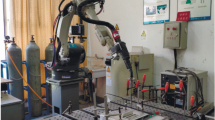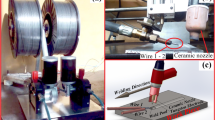Abstract
In this paper, a feedforward neural network is used to model submerged arc welding (SAW) processes in hardfacing. The relationships between process parameters (arc current, arc voltage, welding speed, electrode protrusion, and preheat temperature) and welding performance (deposition rate, hardness, and dilution) are established, based on the neural network. A simulated annealing (SA) optimisation algorithm with a performance index is then applied to the neural network for searching the optimal process parameters. Experimental results have shown that welding performance can be enhanced by using this new approach.
Similar content being viewed by others

References
S. Merrick “Hardfacing extends the life of steel mill continuous casters”,Welding Journal, April, pp. 53–56, 1994.
M. Crowther “Submerged arc welding gives economic repair of continuous caster rolls”,Metal Construction, May, pp. 277–281, 1984.
R. Daeman, “Surfacing of continuous casting III rollers”,Welding Institute Research Bulletin, October, pp. 291–298, 1980.
K. G. Budinski, “Hardfacing: an overview of the process”,Welding Design and Fabrication, July, pp. 51–57, 1986.
T. Ellis and G. G. Garrett “Influence of process variables in flux cored arc welding of hardfacing deposits”,Surface Engineering 2(1), pp. 55–66, 1986.
J. A. Freeman and D. M. SkapuraNeural Networks: Algorithms, Application, and Programming Techniques, Addison-Wesley, New York, 1991.
G. Chryssolouris and M. Guillot “A comparison of statistical and AI approaches to the selection of process parameters in intelligent machining”,ASME Journal of Engineering for Industry,112, May pp. 122–131, 1990.
T. W. Liao and L. J. Chen “A neural network approach for grinding processes: modeling and optimization”,International Journal of Machine Tools Manufacture 34(7), pp. 919–937, 1994.
B. Y. Lee, Y. S. Tarng and S. C. Ma “Modeling of the process damping force in chatter vibration”,International Journal of Machine Tools Manufacture 35(7), pp. 957–962, 1995.
S. Kirkpatrick, C. D. Gelatt and M. P. Vecchi, “Optimization by Simulated Annealing”,Science 220 (4958), pp. 671–680, 1983.
R. A. Rutenbar, “Simulated annealing algorithms: an overview”,IEEE Circuits and Devices Magazine 5(1), pp. 19–26, 1989.
B. W. Lee and B. J. SheuHardware Annealing in Analog VLSI Neurocomputing, Kluwer Academic Publishers, London, 1991.
S. Geman and D. Geman “Stochastic relaxation, Gibbs distributions and the Beyesian restoration of images”,IEEE Transactions on Pattern Analysis and Machine Intelligence 6(6), pp. 721–741, 1984.
C. Zhang and H. P. Wang, “The discrete tolerance optimization problem”,ASME Manufacturing Review 6(1), pp. 60–71, 1991.
D. Rumelhart and J. McCelland,Parallel Distributed Processing, vol. 1, MIT Press, Cambridge, 1989.
N. Metropolis, A. Rosenbluth, M. Rosenbluth, A. Teller and E. Teller “Equation of state calculation by fast computing machines”,Journal of Chemical Physics,21, pp. 1087–1092, 1953.
Author information
Authors and Affiliations
Rights and permissions
About this article
Cite this article
Tsai, H.L., Tarng, Y.S. & Tseng, C.M. Optimisation of submerged arc welding process parameters in hardfacing. Int J Adv Manuf Technol 12, 402–406 (1996). https://doi.org/10.1007/BF01186928
Issue Date:
DOI: https://doi.org/10.1007/BF01186928



